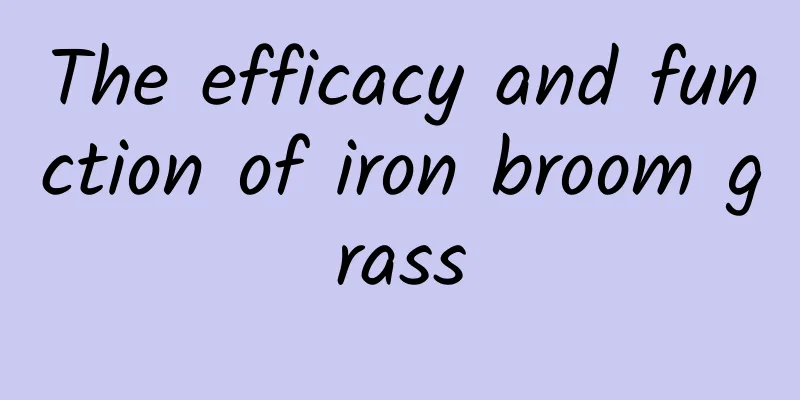The efficacy and function of iron broom grass

|
The iron broom is not the broom we often talk about, but a kind of plant that we are not familiar with. Because we are not very common, we are not very clear about its shape characteristics, functions and effects. Let’s follow the editor to learn about the functions and effects of the iron broom. Iron Broom Also known as night gate, cockroach wings, iron horse whip, three-leaf male and female grass, and fish string grass. Effects and functions: Clears away heat and dampness, aids digestion and eliminates accumulation, relieves cough and resolves phlegm. It is used for infantile malnutrition, indigestion, gastroenteritis, bacterial dysentery, stomachache, icteric hepatitis, nephritic edema, secretions, stomatitis, cough, bronchitis; it can be applied externally to treat herpes zoster and centipede bites. The drug has a mild effect and tastes sweet and bitter. Aliases Night door closing, cockroach wings, iron horse whip, three-leaf male and female grass, fish string grass. Natural environment for growth and development Growing in wilderness, hilly terrain, hillsides and roadsides. It is also planted near fields and houses. From Lespedeza cuneata (Dum-Cours.) G.Don, a green plant of the genus Lespedeza in the legume family, is used as medicine with its roots and the whole plant. Dig up the roots and whole plants in summer and autumn, wash, chop and dry them. Nature and flavor Sweet, slightly bitter, neutral. Efficacy and function Clears away heat and dampness, aids digestion and eliminates accumulation, relieves cough and reduces phlegm. It is used for infantile malnutrition, indigestion, gastroenteritis, bacterial dysentery, stomachache, icteric hepatitis, nephritic edema, secretions, stomatitis, cough, bronchitis; it can be applied externally to treat herpes zoster and centipede bites. Usage method Dosage 0.5~1 liang; for external application, crush it and apply it to the wound. Shape characteristics Erect herb, 30-100cm high. Old branches are cylindrical with longitudinal grooves; stems are sparsely pubescent and later become glabrous. The leaves are nearly leathery green, often turning gray-black after falling, simple to compound, one to two times pinnately lobed, with lobes linear-lanceolate, oblong-lanceolate to elliptic, or linear, 1.5-10 cm long, 0.1-2 cm wide, acute or convex at the apex, sometimes obtuse, entire, sparsely pubescent or nearly pubescent on both sides or along the petiole, with prominent reticulate veins. The inflorescence is terminal, a cyme or a racemose or pyramidal cyme, sometimes solitary, with a diameter of 2.5-5 cm; calyx 4-8, usually 6, milky white, oblong or narrowly obovate, 1-2.5 cm long, 0.3-1 (-1.5) cm wide, densely covered with cotton hairs on the outside, like a cotton ball when in bud, without hairs inside; pistil without hairs. Achenes are obovate, flat, densely pubescent, and persistent style is 1.5-3 cm long with long grayish-white soft hairs. The flowering period is from June to August, and the fruiting period is from July to October. Geographical Distribution In my country, it is distributed in the eastern part of Gansu Province, Shaanxi Province, Shanxi Province, Hebei Province, Inner Mongolia Autonomous Region, Liaoning Province, Jilin Province, and Heilongjiang Province. It grows on fixed sand dunes, dry hillsides or hillside lawns, especially in the Northeast and Inner Mongolia grasslands. There are also people in North Korea, Mongolia, and the eastern part of Western Siberia in the former Soviet Union. Efficacy and function The root has medicinal value, and has the effects of reducing fever, relieving pain, promoting urination, and unblocking meridians. It can treat rheumatism, edema, neuralgia, and hemorrhoidal swelling and pain; as a fertilizer, it has excellent preventive effects on potato diseases and planthoppers. Nature and flavor Sweet, slightly bitter, astringent, flat and cool. Efficacy and function Clears away heat and dampness, aids digestion and eliminates accumulation, relieves cough and resolves phlegm, and is a diuretic and relieves stranguria. It is used for infantile malnutrition, indigestion, gastroenteritis, bacterial dysentery, stomachache, icteric hepatitis, nephritic edema, secretions, stomatitis, cough, bronchitis; it can be applied externally to treat herpes zoster and centipede bites. Conclusion: Through the introduction of the above article, do we have a certain understanding of the relevant knowledge of iron brooms? Although iron brooms are not common, they have many uses. We can selectively use the methods introduced above according to our own needs, but we must understand the methods of use and not abuse them blindly. |
<<: The efficacy and function of wild mountain seven
>>: Huanglian Wendan Decoction
Recommend
The efficacy and function of Astragalus membranaceus
Su Huangqi is very familiar to everyone. Su Huang...
Will Sirius explode as a supernova? What will happen if it explodes? How much impact will it have on humans?
This title may look a bit scary, but please rest ...
The "magic weapon" used by microorganisms to communicate is actually an accomplice of blue-green algae blooms?
Produced by: Science Popularization China Author:...
How much soapberry should be used?
Soapberry is a common Chinese medicinal material ...
Beethoven's hair gene sequencing research is out! Revealing the real cause of death
In March 2023, the journal Contemporary Biology, ...
Can I take Panax notoginseng powder if I have cerebral infarction?
Everyone knows that cerebral infarction is a dise...
2022 Abel Prize winner Sullivan: A mathematical helmsman who connects different fields
The 2022 Abel Prize was awarded to American mathe...
Will walking after a meal cause gastroptosis? How should you “walk a hundred steps after a meal”? Today we finally have the answer!
gossip When many of my friends were young, they w...
Can Panax notoginseng be eaten in summer?
Many Chinese medicines require specific time for ...
After three rehearsals, the first flight of the new generation of moon landing rocket has no date
Do you remember NASA's new generation manned ...
The efficacy and function of Chollima
The medical value of the Thousand-Li Horse is bey...
The efficacy and function of golden buttons
We know that there are many kinds of Chinese medi...
The efficacy and function of white grass
White grass can not only supplement the body'...
The efficacy and function of pecan peel
Pecan peel is very familiar to everyone. Pecan pe...









